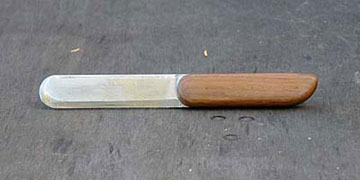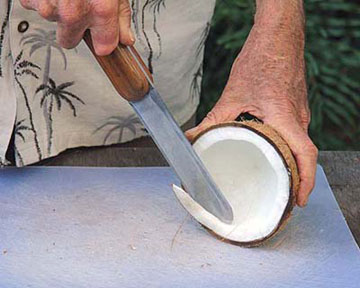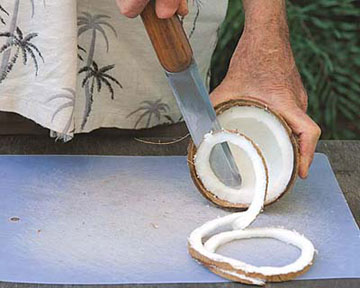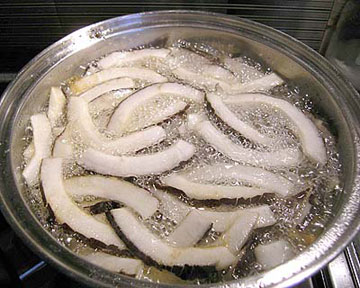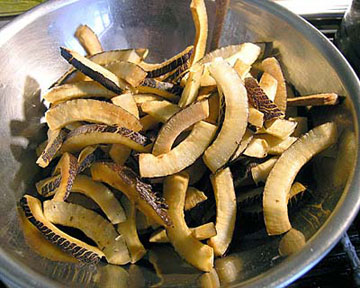|
E-Mail Edition Volume 5 Number 3 |
|||
|
Originally published Summer, 2008 Published by Piccadilly Books, Ltd., www.piccadillybooks.com. Bruce Fife, N.D., Publisher, www.coconutresearchcenter.org |
|||
|
If you would like to subscribe to the Healthy Ways Newsletter
|
Contents
|
||
|
|
Coconut Oil and Alzheimer's Disease The most effective treatment for Alzheimer's may be sitting on your cupboard self. Doctor discovers effectiveness of coconut oil in fighting neurodegeneration.
From time to time I receive testimonials from people who attest that coconut oil helped them or a family member overcome neurological problems. These problems include Parkinson's disease, multiple sclerosis, autism, dementia, epilepsy, and various emotional disorders. Of these conditions, the effects of coconut oil or the fatty acids in coconut oil on epilepsy are the most thoroughly studied and documented. However, new research on Alzheimer's disease has shown that coconut oil may be the best alternative treatment for this otherwise untreatable condition.
Recently, I received a copy of a letter addressed to Supreme Court Justice Sandra Day O'Connor and other members of the Alzheimer Study Group. I would like to share some of the contents of this letter with you.
The letter was written by Mary T. Newport, MD, Director of Neonatology at Spring Hill Regional Hospital in Florida. About five years ago Dr. Newport's husband, Steve, began to develop signs of Alzheimer's disease. At the time Steve was only 53 years old. The disease progressively worsened and according to Dr. Newport is now "moderately severe." Steve's latest MRI shows extensive atrophy in the amygdale and hippocampus, the areas affected by Alzheimer's. He lives at home where his health care is supervised by his wife.
During this time, Dr. Newport searched endlessly for ways to curb the progression of the disease. She learned of some clinical trials recruiting Alzheimer's patients for studies to test the effectiveness of two experimental drugs. In researching the drugs she discovered that one of them, Ketasyn, showed great promise. In preliminary studies persons with Alzheimer's disease demonstrated overall improvement in mental ability in as little as 45 days. Positive results were noticeable in some of the subjects after just a single dose. She recognized that this drug had the potential to be the most effective treatment on the market for preventing and reversing symptoms associated with Alzheimer's disease.
During her research, she discovered that the active ingredient in Ketasyn was medium chain triglycerides (MCT)—which are derived from coconut oil. Since the drug was not yet approved for treatment of Alzheimer's by the FDA and was not commercially available, she went to the health food store and purchased a bottle of virgin coconut oil. The daily dosage of MCT oil used in preliminary studies was equivalent to about 2½ tablespoons of coconut oil.
"I started adding 2½ tablespoons to my husband's oatmeal at breakfast," says Dr. Newport. "Within a few days there was noticeable improvement in his gait, his ability to converse, his sense of humor has returned; he remembers the month and the season immediately, which he could not remember if repeated over and over to him before. He is following through on things that he wants to accomplish during the course of the day...To see this much improvement in such a short time is very encouraging for both of us. He is well aware that he is suffering from this disease and fully supports and enjoys our dietary change."
In the hospital where Dr. Newport works, some nurses are from the Philippines. "My nurse friends from the Philippines have advised me that in their country of origin (as well as other Asian countries), coconut and coconut oil are a staple, used on a daily basis, which may explain why there is a much lower incidence of Alzheimer's disease in that part of the world."
How do the medium chain triglycerides in coconut oil fight Alzheimer's disease? During digestion, MCTs are broken down into medium chain fatty acids, some of which are converted into ketones. Nerve tissue, including the brain, relies on glucose for energy. Nerve cells can also convert ketones into energy. When food is restricted and adequate glucose is unavailable, the body converts fat into ketones, which supplies the brain with the energy it needs to function properly.
Certain conditions, such as chronic inflammation, can cause cells to become insulin resistant. Insulin is a hormone that takes glucose from the bloodstream and shuttles it into the cells. Glucose cannot enter cells without the aid of insulin. In insulin resistance, insulin receptors do not function properly and cannot adequately transport glucose into the cells. When inflammation affects nerve tissue, nerve cells become insulin resistant. Therefore, the brain is unable to get the glucose it needs and nerve cells degenerate and die, leading to neurological problems such as Alzheimer's disease, Parkinson's disease, Huntington's disease, and other neurological disorders.
Ketones do not require the aid of insulin to pass through cell membranes. Therefore, they can supply brain cells with needed energy regardless of insulin status. Diseased brains, which are starving for nourishment, get the energy they need from the ketones the body manufactures from the coconut oil. Other fats and oils will not convert to ketones unless a state of starvation exists, so they are of no benefit.
Dr. Newport discovered that the science behind the use of MCTs to treat neurological disorders has been around for a number of years, but little has been done to use this knowledge to development treatments for Alzheimer's and other neurological conditions. MCTs and coconut oil are natural products and as such, are not patentable, so drug manufacturers have little interest in researching their therapeutic potential. Likewise, the government and medical profession, which are greatly influenced by the pharmaceutical industry, have shown little interest.
She laments that had she known about MCTs, she could have begun treating her husband sooner. "Just three years ago my husband's MRI was 'normal' and he could work as an accountant." Now, it may be too late: "realistically speaking, I cannot expect him to fully recover." If she could have started him on the coconut oil when the symptoms first arose, she believes his mind would not have deteriorated to the state it is in today. In fact, he may have retained all of his mental capabilities.
Disturbed by the lack of action taken by the government and medical profession, she wrote a letter to key individuals imploring them to "study the research and make the findings public knowledge so that everyone who suffers from this disease can potentially benefit." In addition to Justice O'Conner and myself, letters were sent to Senator Hillary Clinton, Dr. Steven K. Galson, acting Surgeon General of the U.S., Dr. Mehmet Oz at NBC studios, the medical editors of the New York Times and Washington Post, and many other influential individuals. Will Dr. Newport's campaign bring about greater awareness of the health benefits of coconut oil? Only time will tell. ■
|
||
|
Do Statins Make You Stupid? By Tara Parker-Hope
Cholesterol-lowering statin drugs have had a rough time of it lately. There was the headline-making trial of the statin-combination drug Vytorin, which rattled conventional wisdom about the value of lowering cholesterol. Business Week weighed in with a report that asked: "Do Cholesterol Drugs Do Any Good?" And my Well column in Science Times last month pointed out that there's no data to show that statins prolong the lives of many people who use them. Now, the Wall Street Journal has joined the fray. Health Journal columnist Melinda Beck revisited questions about whether statin drugs have cognitive side effects that leave users, particularly women, with muddled thinking and forgetfulness. "This drug makes women stupid," Dr. Orli Etingin, vice chairman of medicine at New York-Presbyterian Hospital, declared at a recent luncheon, according to the Journal. Dr. Etingin, who is also founder and director of the Iris Cantor Women's Health Center in New York, told of a typical patient in her 40s, unable to concentrate or recall words. Tests found nothing amiss, but when the woman stopped taking Lipitor, the symptoms vanished. When she resumed taking Lipitor, they returned. Over the years, there's been a lot of discussion about whether statins affect thinking and memory, but drug makers point out that hundreds of studies haven't shown a causal link between statins and memory problems. However, anecdotal reports continue to suggest that some patients do develop memory loss while taking the drugs. After I wrote about the issue several years ago, a colleague who had once memorized poetry as a hobby told me he was unable to remember poems once he started taking statins. Dr. Beatrice A. Golomb, assistant professor at the University of California at San Diego, has collected thousands of stories from patients about statin side effects. She has said common complaints from patients taking statins include being unable to remember the name of a grandchild, walking into a room and forgetting why you are there, or starting a sentence and being unable to finish. Some complain of personality changes or irritability. Researchers at the University of California at San Diego are nearing completion of a randomized controlled trial examining the effects of statins on thinking, mood, behavior, and quality of life. Separately, the UCSD researchers are collecting anecdotal experiences of patients, good and bad, on statins; memory problems are the second most common side effect, after muscle aches, in about 5,000 reports to date. "We have some compelling cases," says Beatrice Golomb, the study's lead researcher. In one of them, a San Diego woman, Jane Brunzie, was so forgetful that her daughter was investigating Alzheimer's care for her and refused to let her babysit for her 9-year-old granddaughter. Then the mother stopped taking a statin. "Literally, within eight days, I was back to normal—it was that dramatic," says Mrs. Brunzie, 69 years old. Doctors put her on different statins three more times. "They'd say, 'Here, try these samples.' Doctors don't want to give up on it," she says. "Within a few days of starting another one, I'd start losing my words again," says Mrs. Brunzie, who has gone back to volunteering at the local elementary school she loves and is trying to bring her cholesterol down with dietary changes instead. "I feel very blessed—I got about 99% of my memory back," she adds. "But I worry about people like me who are starting to lose their words who may think they have just normal aging and it may not be." Of course, not every case of mental decline can be reversed by stopping statins. On the other hand, the brain is largely cholesterol, much of it in the myelin sheaths that insulate nerve cells and in the synapses that transmit nerve impulses. Lowering cholesterol could slow the connections that facilitate thought and memory. Statins may also lead to the formation of abnormal proteins seen in the brains of Alzheimer's patients. ■
Article reprinted from The New York Times, July 7, 2008.
To read the entire Wall Street Journal article go to http://online.wsj.com/article/SB120277403869360595.html.html?mod=home_health_right
|
|||
|
The Coconut Oil Story An Interview with Dr. Bruce Fife
For several decades coconut oil and other coconut products were villainized by the medical profession and the media. Today coconut is undergoing a revitalization. This once scorned fruit is now being hailed as one of nature's finest health foods. Much of the credit for this transformation can be given to Dr. Bruce Fife, the author of numerous books on coconut. What most people don't know is how coconut oil, the bad boy of dietary fats and oils was transformed seemingly overnight into the "world's healthiest oil." In this interview, Dr. Fife tells us the rest of the coconut story.
You are called "Dr. Coconut." Where did you get this name? I often travel overseas lecturing on the health benefits of coconut. During my first lecture tour in the Philippines the people, out of appreciation for what I was doing, started calling me Dr. Coconut. Even the newspapers used the term—"Dr. Coconut Visits Manila." The moniker stuck. I like the name and continue to use it myself.
You have been credited as single-handedly bringing awareness of the health benefits of coconut oil to the world and reviving the coconut industry. How did you become interested in coconut? My interest started about 13 years ago. At that time a colleague told me that coconut oil did not cause heart disease and that it was one of the "good" oils. I couldn't believe it. At this time, I was brainwashed like everyone else, believing that all saturated fats, including coconut oil, were dietary monsters. My friend cited a few studies that showed coconut oil possessed some medicinal value. I was so intrigued that I began looking up information on coconut oil to either confirm her statement or to reconfirm my beliefs. Since everyone seemed to "know" that coconut oil caused heart disease, I thought it would be easy to find magazine articles discussing the topic. But I couldn't find any. At the time, there weren't any articles on coconut oil. I did find at lot of articles on fats, oils, and nutrition and the only thing they said about coconut oil was that "coconut oil is a saturated fat and causes heart disease." I read this statement in almost every source I found. But none of these sources ever backed up that statement with any facts, figures, or citations to medical studies. I realized that if I was going to find the truth about coconut oil, I wasn't going to get it from magazine articles or books, because it was apparent that none of these authors know anything about it. The only way I was going to learn the truth was to go to the medical research and see what researchers had to say. I looked up everything I could find on coconut oil, as well as saturated fat, polyunsaturated fat, and related topics. I read hundreds of research articles. What I found was a revelation. I learned that coconut oil was an incredible food with many health benefits. I also learned that it does not promote heart disease but fights against it. I also learned that saturated fat is not the evil villain it has been made out to be and that polyunsaturated fat and hydrogenated vegetable oils were actually the real troublemakers. This went against everything I had previously believed. After analyzing all these medical studies, my beliefs on fats and oils were completely changed. I was so excited about what I had discovered that I wrote a book to tell others what I learned. The title of the book was Saturated Fat May Save Your Life! The book was published in 1998 and in it I devoted an entire chapter to the health benefits of coconut oil. This was the first book ever published, to my knowledge, that revealed the true character of coconut oil. The book Know Your Fats by Mary Enig, PhD, came out in 2000 and it too contained some positive information about coconut oil. By this time, Robert Atkins, MD, had been promoting the low carb diet for several years and insisted that saturated fats weren't so bad after all, but he said nothing about coconut oil.
You've written several books entirely on coconut. When was your first coconut book written? In 2000 I published a book titled The Healing Miracles of Coconut Oil. This book has gone through four editions and is now titled The Coconut Oil Miracle. This was the first book published that was devoted entirely to the health and nutritional aspects of coconut oil. Before I published the book I gave a copy of the manuscript to Jon Kabara, PhD, for review. Dr. Kabara is an emeritus professor of chemistry and pharmacology at Michigan State University and a prominent researcher on fats and oils. He had been studying the health effects of coconut oil for nearly 50 years. He told me that my book was factual and accurate, but advised me not to publish it. The reason was that I would be wasting my time; no one would buy the book because they wouldn't believe it. In addition, I would open myself up to a multitude of criticism and ridicule. He had tried for decades to tell people about the goodness of coconut oil but was criticized. So he spoke from experience and wanted to spare me the pain. I ignored his warning and published the book anyway.
Prior to 2000 I don't think I ever saw coconut oil being sold in stores. Were there many stores that sold coconut oil back then? At the time of publication it was nearly impossible to find coconut oil in local stores. If you were lucky, you might find it sold as a body lotion, but not as a food. I looked everywhere for sources of coconut oil. I was able to find only one reliable source that was being sold for food, and it was refined coconut oil, not virgin coconut oil that is being sold today. Because coconut oil was so hard to find, I included the contact information to this supplier in the book.
Publishing a book that went against the prevailing beliefs of the medical profession was a gutsy move. When your book was initially published, how was it received? I faced a lot of resistance. Even though I sent out many review copies, the media completely ignored it, so I couldn't get any reviews or publicity. People didn't believe coconut oil could be healthy. I received a lot of criticism accusing me of promoting a dangerous product and often suggesting that I was doing this just to sell coconut products, which I didn't do. I knew from that start that when I published the book I would be criticized, so I took it in stride and didn't let the negative comments bother me. Sales of the book were very slow. However, if I could get someone to read the book, I gained a convert and they often told their friends about it. So by word of mouth, more than anything else, the book slowly began to sell. In 2001 a few companies started selling coconut oil over the Internet. They loved my book and sold it along with their oil. The Price-Pottenger Nutrition Foundation and the newly formed Weston A Price Foundation spoke positively of coconut oil in their newsletters. Health food stores slowly began to stock coconut oil on their shelves. The big breakthrough came when I submitted the book to the editors of Woman's World magazine in 2003. They have a readership of several million. They published an article on coconut oil that had an enormous impact. That single article created an instant demand for coconut throughout the country. All coconut oil suppliers and distributers sold out in a matter of weeks. Coconut oil producers overseas were backlogged for months to fill orders. Those outlets that never sold coconut oil before began to stock it. Coconut oil has been selling well ever since. Today every health food store in the US and Canada sells two, three, four, or more different brands of coconut oil. Even mainstream stores like Safeway and Wal-Mart carry it. The spark of interest from the Woman's World article led to numerous other articles in print and on the Internet.
You've written several additional books on coconut. What led you to write these books? In my first coconut book I briefly discuss the weight loss aspects of coconut oil. Many people wrote to me to tell me how successful they had been at losing excess weight using coconut oil. I had testimonies and I had the science to back it up, so in 2003 I decided to write an entire book on the topic. This book was titled Eat Fat, Look Thin. As coconut oil became more popular people contacted me and asked how they could incorporate it into their everyday diets. This led me to write a third book on coconut titled Coconut Lover's Cookbook in 2004. One of my best selling coconut books, Coconut Cures, came out in 2005. To date, I have written seven books on coconut. Seeing the increased interest in coconut oil, several other authors began writing books on coconut as well. Mary Enig's book Eat Fat, Lose Fat was published in 2005.
What effect have your books had on the coconut industry? The impact it has had in third world countries has been nothing short of phenomenal. When the soybean industry began its attack on the tropical oils in the mid-1980s, coconut oil sales plummeted. Not only the oil, but all coconut products suffered. Food manufactures began taking the oil and coconut meat out of their products. The market for coconut oil and other coconut products worldwide dried up. Consequently, the coconut industry went into a deep recession. Factories closed down, coconut farms were abandoned, the trucking and shipping industry was adversely affected, literally millions of people found themselves out of work and unable to find employment. In the island countries of the South Pacific, coconut production contributes to as much as 80% of their economy. So when coconut sales fell, these countries were thrown into an |
|||
|
|
|
economic depression. In the Philippines, one-third of the population depends on coconut for their livelihoods. That amounts to over 20 million people in just one country alone. The majority of these people barely made a living as it was, and now with the drop in demand for coconut oil and other coconut products the majority were thrust into complete poverty. Many people who could not find work and could not feed or clothe their families became angry. Their governments were too poor to give much help. This led them to take up arms and rebel against the government and many coups |
|
|
Children were growing up in poverty.
|
|||
|
and insurrections occurred as a consequence. This is the way it remained until my books on coconut hit the market. The books created renewed interest and demand for coconut products. With the |
|||
|
|
rising demand for coconut, factories went back into full production, farmers started harvesting their coconuts, trucking of coconuts got back into full swing. People were going back to work and earning an income and pulling themselves out of poverty. Parents now had enough money to feed and clothe their families. Children could stop begging in the streets and could go to school instead. The insurgents hiding in the jungles and on mountain tops laid down their guns and came out to work in the fields and factories. They finally got what they were fighting for—an |
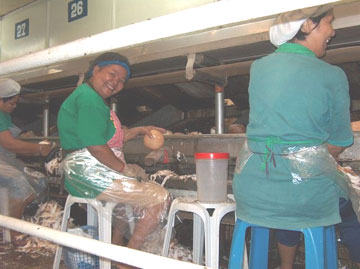 |
|
|
People are grateful to have employment.
|
|||
|
|
|
opportunity to support their families. The economy of dozens of countries benefited and so did the political environment. When I went to the Philippines for the first time in 2004, I was treated like a celebrity and everybody seemed to know who I was. I met hundreds of people all thanking me for what I had done for the coconut industry in their country. I autographed copies of my book at an |
|
|
Children worldwide are benefiting from increased demand for coconut products
|
|||
|
international food trade show and spent many hours signing books. The line to get an autograph was so long that people were going to my wife and having her sign her name in the books because they couldn't get my signature. |
|||
|
|
|
It was unreal. I returned the following year and it was the same. But this time I was also invited to the presidential palace and met with Philippine President Gloria Macapagal-Arroyo, who thanked me for the work I was doing with coconuts and the benefit it was having on her country. I've traveled to Jamaica, Fiji, Indonesia, Singapore, Australia, Thailand, Mexico, and even to the Middle East and Europe to share my knowledge about coconuts and speak to very appreciative |
|
|
Left to right: Secretary Yapp, President Arroyo, Leslie and Bruce Fife.
|
|||
|
crowds. I'm still amazed at how a single book has impacted so many lives around the world. For this reason, I continue to research and promote coconut. Not only is coconut improving our health, but it is improving the economy of many countries and helping to bring stability to governments.
Coconut oil has been a great help to many people in the US and Canada as well. It is a natural product that in many ways is just as good, if not better than many medications. What impact is coconut oil having on the health of people in third world countries? In many of these poor areas the people can't afford to buy medicines. So the people use traditional remedies or do without. However, with the newfound knowledge of coconut oil's healing properties, people can use it to treat various illnesses without the expense or danger of using drugs. Coconut oil and other coconut products can do so much that drugs aren't necessary in most cases. Coconut oil and other coconut products are effective in preventing and treating a large number of health problems. I constantly receive testimonials from people telling how they used coconut oil or another coconut product to cure some chronic or acute illnesses or better their health and lives in some way. The reason why coconut oil is still popular and gaining in popularity is because it WORKS! If it didn't, it would have died out long ago, just like numerous health fads that have come and gone in the past.
Do you have any more books on coconut in the works? I'm continually learning more about the wonders of coconut. I just finished a book on the health benefits of coconut water. This book, titled Coconut Water for Health and Healing, was published this past January. Coconut water is an amazing health tonic with benefits that are very much different from the oil or meat, but just as remarkable. At the 2008 BookExpo America—the largest book industry trade show in North America—I had the great honor of being presented a Silver Medal from the Nautilus Book Awards for this book. The nautilus book awards are presented annually to those books which are judged to be the most influential in promoting positive changes in the world and inspiring independent thinking, personal growth, improved wellness, and social change for the better. I am currently working on three new books that involve coconut in one way or another. My next book will be coming out this August. It's titled Oil Pulling Therapy: Detoxifying and Healing the Body Through Oral Cleansing. I'm really excited about this book. If you think my other books were groundbreaking, wait until you read this one; it will blow you away. You can read about all my books at www.piccadillybooks.com. ■
|
|||
|
The Coconut Slicing Knife
The Coconut Slicing Knife (aka the Universal Coconut Knife) was invented by Mike Foale of Brisbane, Australia. With this knife you can free a |
|||
|
|
|
ripening coconut from the tree, crack it open, and peel out the flesh in easy-to-eat strips. With the dull edge of the knife, a coconut can be split in two with one or two well-placed strikes. The sharp rounded end of the knife is then used to cut and peel the meat |
|
|
|
|
|
|
|
off the half shell. The meat can be cut to produce a spiral of coconut meat. With the coconut strips you can enjoy a fresh snack or make coconut fries (see recipe below).
|
|||
|
COCOS FRIES: A PROMISING NEW WAY TO PROCESS COCONUT KERNEL By Mike Foale
Abstract A new process is described for processing the kernel of the coconut in order that it may be stored in ambient conditions for convenient dietary and snack use. Deep frying of pre-frozen strips of coconut kernel has yielded a very attractive product that might gain commercial use with adequate characterization, energetic promotion, and attractive presentation. It appears that this product could compete with other oil-bearing snacks such as peanut, cashew and pecan thereby entering a very lucrative market. Production that involves shareholding by small-holders could provide a much needed boost to income in depressed coconut communities.
Introduction In the course of the past 160 years the coconut has remained a steady staple in the diet of hundreds of millions of people in the coconut heartlands of Asia and the Pacific while gaining increasing use in Africa, the Caribbean, and Latin America. Over that same period, following the "discovery" of coconut oil by European traders in the early 19th century, it has enjoyed a roller-coaster ride as a commodity in world trade. The peak of the value of coconut to industrialized populations outside of the tropics extended from the late 19th century, as supplies of whale oil turned down, until the Great Depression of the 1930s. Valiant efforts to revive demand for coconut following World War 2 were stifled by the producers of highly mechanized oil-seed crops—particularly soybean—outside the tropics. The success of carefully crafted messages about the health impact of different chemical forms of oil in depressing demand for coconut is well-known and need not be repeated here. A relatively recent development, however, drawing on the marketing strategy of the producers of olive oil—like coconut, another tree-based oil—is the rise of Virgin Coconut Oil in tropical and temperate markets. Although main-stream health professionals have yet to fully embrace VCO, it appears to be making significant inroads into the market for health products. The fact that it is regarded almost as a medication, rather than a treat, has dampened its wider adoption beyond the generally health-conscious element in the community, although the price it commands shows that demand is strong. In order to enter into the market for "recreational" nut foods, such as salted peanut or cashew, I have attempted to develop a derivative of the coconut kernel that is visually attractive, tasty, is nice to chew, and probably retains chemical integrity close to that of VCO. This new product, known for the time being as Cocos Fries, is the subject of this brief note.
Preserving Coconut Kernel The most popular coconut product among consumers in industrialized countries is Desiccated Coconut (DC), which is an important ingredient in home-made sweet items and manufactured snack bars. The intensity of the drying of DC, which is important to its extended shelf life, diminishes the coconut flavor to some extent, so that sweetening is commonly added to enhance the taste attraction. Preservative is often used also to protect the shelf life. By contrast, the other great kernel derivative is copra, which was the foundation of the trade between the coconut world and clients in temperate countries. Copra was the product of drying kernel, generally without any special attention to hygiene, while concentrating on getting the kernel to the drier as quickly as possible after splitting the nut. Quality varies a great deal depending on how rapidly the drying was done, how dry the material became (ideally 6% moisture meant a stable product) and how long the interval was between drying and delivery to the oil expeller on the other side of the world. In most supply systems the quality of the oil extracted from copra required refinement, especially for the food market. A new approach to drying the kernel by means of deep frying is based on modified traditional practice found in some parts of Indonesia where the fried product was passed immediately to the expeller. However, this deep-fried :"copra" is very different from that dried in hot air, having an attractive additional flavor due to browning of the surface, and avoiding any significant chemical change in the oil because the process takes little more than one hour at ideal oil temperature. One major change to the traditional method of deep frying has give rise to Cocos Fries, which are tasty and have an extended shelf life.
Cocos Fries — Method of Production The kernel is sliced from a fresh mature coconut in narrow strips 6 to 8mm wide using a knife similar to those used on some plantations to extract the kernel from split nuts in the field. |
|||
|
|
The kernel strips are then placed in a freezer until fully frozen. This freezing step makes a great difference to the dryness of the surface of the kernel, which will be explained later. After defrosting and washing, the strips are submerged in cooking oil in a saucepan, preferably coconut oil, but olive oil is also suitable, as would be palm oil. The infusion of a small amount of oil of another type does not appear to impair the coconut flavor of the fries. Frying is done with moderate heat which generates vigorous bubbling as the moisture in the coconut is converted into water vapor, which |
|
|
|
escapes. Depending on the size of the batch, deep frying takes 30 to 60 minutes. Once most of the moisture has been driven off, the oil temperature begins to rise, causing some color to develop on the surface of the coconut strips. Frying |
|||
|
|
|
should be stopped when most of the strips of coconut show some color ranging from gold to brown. The oil is poured off at this point and the coconut left in a strainer or other container to "drain." Remarkably, the surface of the strips develops a dry appearance and feel after an hour or two, as it seems that any oil on the surface is absorbed into the matrix. It appears that the freezing has |
|
|
"loosened up" the fibers somewhat, allowing internal water to more readily boil off and later allowing surface oil to be drawn in. The Cocos Fries are packed in a paper bag to enable further air drying to take place. In a sealed container some moisture from within the strips makes its way to the surface and may support colonization by microbes. The paper bag will absorb traces of oil from the Fries. If more adventurous flavors than pure coconut are required, that would be just a matter of adding a chosen spice to the frying oil.
Properties of Cocos Fries As yet there are no scientific data to characterize the physical or chemical properties of Cocos Fries. It is likely that little chemical change has happened as the temperature would not have risen far above 100 degrees C for most of the process and the browning phase, when the oil temperature rises a little further, lasts only for a few minutes. From the consumer's point of view the Fries are very tasty, possessing a mixture of genuine coconut flavor with an overtone of the caramelisation that generates the golden-brown color. While warm, immediately after cooking, the texture of the Fries is remarkably soft, but when cool (and especially when cold) they are quite "chewy". As the water content is close to 5%, the oil content would be around 60%, so that the fries may be regarded as a concentrated source of coconut oil. For those who have access to fresh coconuts, generating one's own supply of this product provides a ready source of dietary coconut oil which has a convenient shelf life, even without refrigeration, of many weeks. (If the strips are not pre-frozen, however, the shelf life is only a few days as it appears that thorough drying is very hard to achieve without the texture changes provided by freezing). Cocos Fries may well provide an alternative, in terms of enjoyment of the flavor, to other nut types that are served at parties and entertainment events where snacks are provided. The health advantage might also be pursued to promote this use.
What Is the Future for Cocos Fries? In my view there appears to be commercial potential for the manufacture and export of Cocos Fries based on thorough product specification and imaginative marketing. A private company seeking new products or a coconut research institution might be interested to optimize the production process, and carry out chemical analysis of the product to confirm the integrity of the oil components. If the product shows promise through comprehensive market research in competing with other nuts in the market-place, research into packaging and the best form of presentation would likely follow. The process of extracting the strips from the nut would perhaps be merchandisable by deshelling, as is done in DC processing, followed by slicing of the whole kernel using a tool resembling a bread loaf slicer. Although at first acquaintance the Cocos Fry appears little different from copra, its color, texture and flavor might provide the foundation for a new product in the snack food and health food markets. ■
|
|||
|
Do you have friends who would like this newsletter? If so, please feel free to share this newsletter with them.
If this newsletter was forwarded to you by a friend and you would like to subscribe, click here.
Copyright © 2008, Bruce Fife. All rights reserved.
|
|||



